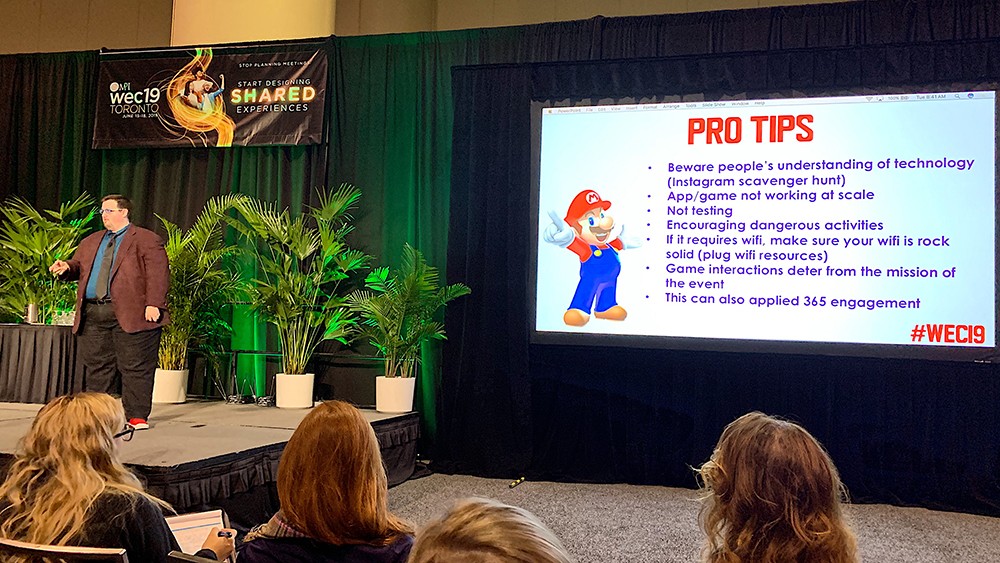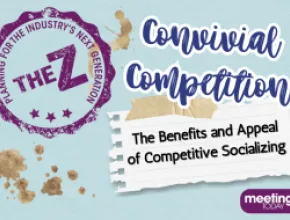The gaming industry is huge. So huge, it brought in more revenue than TV, movies and music last year, at a cool $116 billion. On average, three billion hours of games are played per week, worldwide.
Meeting planners can harness this popularity of game playing and apply its elements—like competition, scoring points and rules of play—to enhance their events, according to Alex Plaxen, president and founder of Little Bird Told Media and Will Curran, founder and chief event Einstein at Endless Events.
Following are tips from Plaxen and Curran for using gamification to influence attendee behavior during an education session at MPI’s 2019 World Education Congress (WEC).
When to Use Gamification During Your Event
Plaxen explained that gamification can be used throughout your event—from the registration process to activations within sessions and meetings.
The only time he cautioned against using gaming elements during your event is when a keynote speaker is presenting, which often requires careful planning and financial investment.
“You want to make sure the game doesn’t deter from the mission of your event,” Plaxen said.
The best time to apply gamification strategy to your events is by enhancing actions your attendees are already taking.
Plaxen told the story of a previous client of his, who was known for collectible buttons at their event. Previously, they were just available at the information desk.
[Related Content: 4 Tips to Measure Social Media Analytics for Your Next Event]
Plaxen suggested they give buttons to each of the exhibitors, encouraging attendees to attend all the sessions to collect all the buttons.
“At the end, we had them enter to win a prize by posting a photo on Instagram of all of the buttons,” he said. “We already knew these buttons were popular, collecting them was something attendees were already doing.”
Ways to Gamify Your Event
Plaxen and Curran created a list of simple ways you can gamify your next event:
- Award points for actions: For registering for educational sessions or participating in event activations, award attendees with points. Plaxen said many event apps do this.
- Mini games: Sprinkle mini games throughout the event to promote peer-to-peer collaboration and learning like group scavenger hunts.
- Levels: Like strategies of major airlines, reward participants for their actions by giving them the opportunities to “level up” to a new status that comes with added perks or event prizes.
You can apply these styles of gaming to the activation you choose to create:
- Single: Games that individuals play on their own at any time during the event.
- Co-op: Games that you can only do with other people.
- Team deathmatch: Games where you must compete head-to-head.
Tips for Using Prizes as Engagement Drivers
Game players usually expect a prize for participating. This is no different when it comes to adding gaming elements to your events.
Plaxen explained that the most important characteristic of a prize is to make sure it’s one your audience wants. Popular swag at events, like T-shirts for example, aren’t prizes attendees necessarily want or need. That goes for expensive prizes, too, like iPads. If attendees already own these items, they are less likely to engage in the game at your event.
[Related Content: The Future of Teambuilding Activities at Meetings]
Prizes don’t always have to be material things, they can be experiences, Plaxen suggested.
“Like meeting the keynote speaker, for example,” he said. “That’s a great prize, and it will cost you nothing. Or if you have a keynote, put your top tweeters in the front row.”
“Sponsor those seats in the front row,” Plaxen added. “Your top tweeters—who are already creating content for your event—will take even better pictures. And, they will probably thank the sponsors on Twitter. And this will all cost you nothing.
“You might even make money from sponsors,” he concluded.
Gamifying Your Event: What Not to Do
Though gaming applications can enhance your event, there is the potential for missteps, if not employed correctly. Keep the following in mind:
- Generational differences: Gen Z, for example, is typically not engaged with public sharing social media apps like Facebook. Know your audience before choosing how you apply gamification to your event.
- Troubleshooting: Make sure someone is available to help troubleshoot the gaming elements of your event, like a help desk for technology issues. If your game requires Wi-Fi, make sure the Wi-Fi is rock solid.
- Simplicity: Don’t make the game complex. Simple applications are always better.
- Spam Activities: Plaxen cited an event he attended where connecting with people in the event app scored him points. So, he spammed a bunch of attendees with connection requests to win. His advice: If the action could be done 100 times outside of the game, ask yourself if it would be considered spam. If yes, don’t do it.
- Scavenger Hunts: Scavanger hunts are popular event activations. But don’t encourage dangerous behavior—asking people to take selfies in front of dangerous locations or with strangers on the street, for example, is not recommended.
- The Event Mission: Make sure game interactions don’t deter from the mission of the event.
Editor's Note: Due to travel issues, Will Curran could not attend this WEC session, however, information from the session is credited to both him and Alex Plaxen.
Check out all of our MPI WEC 2019 event coverage in this handy article.







